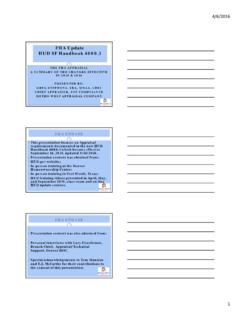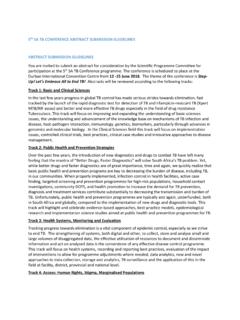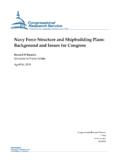Transcription of A Deep Dive Into Shortfalls and Surpluses
1 Rachel BarkleyMunicipal Credit Analyst11 312 November 20121 Sielman, Rebecca. 2012 Public Pension Funding Study. TakeawaysPension funded levels and UAAL vary widely between the 40% of all states fall below morningstar s fiscally sound threshold of a 70% funded per capita is a major indicator as it represents how much each resident would need to pay to fund the liability and can vary compared to funded out for underfunded plans despite a satisfactory aggregate funded GASB requirements will change pension standards and accounting challenges and vulnerabilities facing government pension plans have gained new public prominence and attention of late. Both governing entities and the taxpaying public are beginning to grasp and acknowledge the potential, chronic consequences of looming pension liabilities. During the past several years, ever-escalating pension costs and liabilities have induced new, sometimes unrelenting, pressure on the finances of state and local governments still hampered by the recession.
2 Current data indicates these pressures are expected to persist, even intensify. A recent report from the actuarial firm Milliman, found a $ trillion gap for the largest 100 public pension plans1 while actuarial reports for a large portion of these plans are projecting sizeable increases in required contribu-tions in order to fully fund these liabilities. Despite their importance, the inner workings of pensions remain mired in foggy opacity, due to a combination of their complexity and sheer number, as well as a lack of transparency precipitated by weak disclosure requirements. To get a better view of the present state of major pension plans, and the potential impact of their vulnerabilities on governments, taxpayers, and investors, morningstar has analyzed current data for pension plans administered by each of the 50 states. Overall, we found the fiscal health of state pension plans varies drastically with some states having exceptionally strong plans while others are facing severe funding pension plans are particularly important for several reasons.
3 Not only do they represent a respective state s financial obligations, but they re often structured as umbrella plans covering employees of that state s myriad local government bodies. State pension plans that solely cover state employees can have a notable influence on underlying governments within the state, as states provide substantial aid to school districts and other local governments. Financial pressure on state governments, including the fiscal strain imposed by ballooning pension costs, can lead to reductions in intergovernmental aid to local State of State Pension Plans A Deep Dive Into Shortfalls and Surpluses 2012 morningstar . All rights reserved. morningstar s Credit Research is produced and offered by morningstar , Inc., which is not registered with the Securities and Exchange Commission as a Nationally Recognized Statistical Rating Organization ( NRSRO ). The information contained herein is the proprietary property of morningstar and may not be reproduced, in whole or in part, or used in any manner, without the prior written consent of morningstar .
4 To order reprints, call 11 312 696-6100. To license the research, call 11 312 The State of State Pension Plans: A Deep Dive Into Shortfalls and Surpluses OverviewWhile the majority of states are adequately managing their aggregate pension liabilities, several pension systems are coming under duress. The fiscal solvency and management of these plans varies greatly, according to two key drivers of morningstar s pension analysis: the funded ratio, and unfunded actuarial accrued liability (UAAL, or unfunded liability) per capita. The funded ratio, which is calculated by dividing the pension plan s assets by its liabilities, serves as a good measure of the plan s ability to meet its obligations. In addition, morningstar to highlight the UAAL per capita, which, in our opinion, is a useful metric not commonly applied in the current pension analysis narrative. Similar to the debt per capita calculation in credit analysis, the UAAL per capita represents the amount each person in the state would need to pay to fully fund this unfunded the funded ratio and UAAL calculations, we looked at all defined benefit plans to which the state contributes and/or has a legal obligation to provide funding (see the appendix for a full discussion of the methodology).
5 This brings up two critical points: 1 Pension plans are not required to report the percentage of the total unfunded liability for which each participant accounts under current accounting rules. This is important, as many of these plans have multiple contributing governments, meaning the state will not be responsible for paying the full liability. Because of this, it is difficult to project the impact on the state budget. However, as the other participants are underlying local governments, the UAAL will still be funded by state taxpayers, either through payments to the state, or an underlying entity. 2 Additionally, states are often the administrator of plans to which they have no liability or requirement to contribute. We have excluded these plans from our calculations, given that the states will not be funding these liabilities. We do, however, note that these additional plans administered by the states, as well as local plans not under state administration, represent what can be, at times, significant additional pension liabilities which taxpayers will be required to fund.
6 Overall, funded percentages and UAAL per capita vary dramatically between the states (see maps). Several states have very strong pension systems. Seven states have an aggregate funded ratio of at least 90%, while eight states have UAALs under $1,000 per capita. Wisconsin is currently the strongest system, with a funded ratio and a UAAL of $23 per capita. On the other side of the spectrum, 21 states fall under morningstar s fiscally sound threshold of a 70% funded ratio. Despite the passage of recent reforms, Illinois continues to have the worst funded system, with a funded ratio and a $6,505 per capita there tends to be a relationship between funded level and UAAL per capita, there are multiple notable exceptions in which the two data points do not correlate when rank-ordering the systems. While Illinois has the lowest funded ratio, Alaska has by far the highest UAAL per capita, at over $10,000. This is despite its higher, although still poor, funded ratio of Meanwhile, Indiana has a funded Related ResearchState and Local Pensions 101 Upcoming Reports on Plans for High Profile Individual State Plans333 The State of State Pension Plans: A Deep Dive Into Shortfalls and Surpluses Aggregate Pension Funded Levels by State 80%h Good 70% 79% Fair 69%x PoorAggregate Pension UAAL Per Capita by State $1,499 x Good $1,500 $2,999 Fair $3,000 h Poor4 The State of State Pension Plans: A Deep Dive Into Shortfalls and Surpluses ratio roughly on par with that of Alaska, at However, the UAAL per capita for Indiana is substan-tially lower than that of Alaska, at $2,284, and is even lower than that of more well-funded plans.
7 This substantial disparity in the apparent fiscal health of the systems highlighted by these two data points reinforces morningstar s opinion that the UAAL per capita needs to be taken into consideration when analyzing within well-funded systems, individual plans can often be severely underfunded. The majority of the systems have multiple plans covering different classes of employees. Often, the systems have one or two large plans, typically covering general state employees and/or teachers, along with separate smaller plans for a specific type of employee, such as judicial employees or elected representatives. While the aggregate funded ratio is a good picture of a system s overall health, it largely reflects the funded ratio of larger systems, which can lead to funding issues in smaller plans being overlooked. In aggregate, Minnesota s system is adequately funded, with a funded ratio. Its Legislators Retirement Fund, however, has an exceptionally low funded ratio, while the Elective State Officers Fund has a 0% funded ratio.
8 While these plans are relatively small compared to the system in its entirety, they still need to be considered. Low funded levels in these smaller plans can lead to budgetary majority of plans continue to experience declines in their funded levels, and increases in their UAAL per capita, although volatility has moderated since its peak in 2009. Overall, the universe of plans has experienced gains in the market value of their assets, as of their most recent actuarial valuation. However, most plans do not recognize the full magnitude of actual gains or losses at the end of each fiscal year. Instead, they use a process called smoothing to determine the actuarial value of their assets, which incorporates any deviation between expected returns and actual results over a period of time, typically five years. Smoothing has an impact on periods of both positive returns and negative returns. Consequently, these plans will still have a few more years of absorbing the investment losses suffered during the recession, although gains in recent years offset a significant portion of these losses.
9 Declines in the funded level for each state can be seen in the data funded levels have declined and overall fiscal pressure for states has increased in recent years, many states have implemented some level of pension reforms in response. The majority of these changes have been mandated increases or implementation of employee contributions, changes to formula calcula-tions, and extending vesting periods. The details of these changes and the projected impact on the state s liability, if available, will be addressed in the upcoming pension reports for the applicable states. Pension reforms continue in the latter portion of calendar year 2012, including two of the most populous states with sizeable liabilities: California and Ohio. It is worth pointing out that not all pension reform attempts are successful. The Illinois State Legislature held a special session in August to focus on additional pension reforms, but failed to implement any.
10 Highlights of Recent Ohio Pension ReformIncreases contributions for some public employeesRaises the retirement ageChange in benefit formulaNew guidelines for cost of living adjustments (COLA)3333333 33 Highlights of Recent California Pension ReformCaps benefit paymentsRaises the retirement ageRequires equal sharing of pension costsEliminates certain practices that have elevated payments for some retirees in prior yearsEstimated to provide at least $65 billion in savings between the two major systems5 The State of State Pension Plans: A Deep Dive Into Shortfalls and Surpluses Not All Pension Plans Are Directly ComparableThere exist wide disparities in pension plan structures, managements and accounting practices, making it difficult to compare plans across all states accurately. Two key elements are (1) type of benefit, and (2) plan contributor. Benefit types can range from defined benefit, to defined contribution, or hybrid plans.









